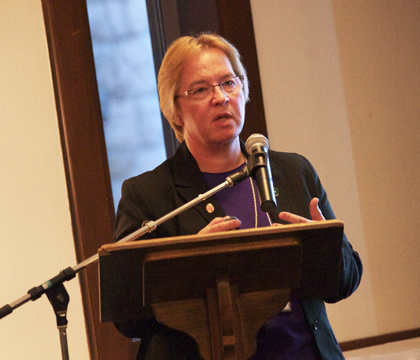The workshop focused on the challenges in developing nuclear biomarkers and nanoprobes (tiny particles used to detect, diagnose and treat disease) to better understand specific disease mechanisms and pathways. Biomarkers help medical imaging specialists measure the severity or presence of disease in the body.
"This workshop will foster the advancement and exchange of health research knowledge and identify pressing needs for research in the area of biomarker development for imaging conditions such as cancer," said Dr. Baljit Singh, associate dean of research at the Western College of Veterinary Medicine (WCVM).
"We will also focus on the development and use of animal models that can help us to learn more about animal and human health."
Organized by the WCVM and the U of S College of Medicine, the workshop brought high-profile speakers to Saskatoon including Dr. John Gore from Vanderbilt University's Institute of Imaging Science in Tennessee, and Dr. Ekaterina Dadachova of the Albert Einstein College of Medicine in New York.
Dayan Goodenowe, president and CEO of Saskatoon-based Phenomenome Discoveries, also spoke about his company's work in developing diagnostic serum biomarkers that target cancer and neurodegenerative diseases.
Before the next generation of biomarkers can be developed, researchers must understand the unique molecular "signature" of a disease. That information is used to develop biomarkers that can be used for precise imaging or targeted drug delivery.
"To accomplish this goal, we need to bring together researchers from areas such as medical imaging, anatomy and cell biology, biochemistry, biomedical sciences, clinical sciences and mechanical engineering," said Dr. Paul Babyn, head of the U of S College of Medicine's Department of Medical Imaging.
More than 60 participants participated in the workshop's breakout discussions and their feedback will be used to develop a recommendations report on biomarker development.
Following the workshop, several of its participants joined a group of people from academia, industry and the public sector at an industry engagement dinner targeting biomarker development. This event was funded through a grant from the Natural Sciences and Engineering Research (NSERC) Prairies Regional Opportunity Fund (ROF) and with support from Philips Healthcare.
The informal dinner at the U of S University Club gave researchers a chance to meet and talk with representatives from biomarker- and imaging-related companies. The evening's speakers included Frank Nolan, development officer from NSERC Prairies Regional Office, and Dr. Deborah Anderson, senior research scientist at the Saskatoon Cancer Centre.
Other special guests included representatives from the Canadian Light Source, MR Vets Inc., NSERC Industrial Research Assistance Program (IRAP), Phenomenome Discoveries Inc., Philips Healthcare, the Saskatoon Health Region, Sylvia Fedoruk Centre, University of Tennessee, University of Toronto, Vanderbilt University and Yeshiva University.
The workshop and the dinner were the ideal fit for the U of S where medical imaging, nuclear medicine and synchrotron sciences are key components of the university's future plans for research and advanced education.
Download a copy of "Challenges to Biomarker Development in Canada" that is based on recommendations from the 2014 biomarker development workshop at the U of S.
"This workshop will foster the advancement and exchange of health research knowledge and identify pressing needs for research in the area of biomarker development for imaging conditions such as cancer," said Dr. Baljit Singh, associate dean of research at the Western College of Veterinary Medicine (WCVM).
"We will also focus on the development and use of animal models that can help us to learn more about animal and human health."
Organized by the WCVM and the U of S College of Medicine, the workshop brought high-profile speakers to Saskatoon including Dr. John Gore from Vanderbilt University's Institute of Imaging Science in Tennessee, and Dr. Ekaterina Dadachova of the Albert Einstein College of Medicine in New York.
Dayan Goodenowe, president and CEO of Saskatoon-based Phenomenome Discoveries, also spoke about his company's work in developing diagnostic serum biomarkers that target cancer and neurodegenerative diseases.
Before the next generation of biomarkers can be developed, researchers must understand the unique molecular "signature" of a disease. That information is used to develop biomarkers that can be used for precise imaging or targeted drug delivery.
"To accomplish this goal, we need to bring together researchers from areas such as medical imaging, anatomy and cell biology, biochemistry, biomedical sciences, clinical sciences and mechanical engineering," said Dr. Paul Babyn, head of the U of S College of Medicine's Department of Medical Imaging.
More than 60 participants participated in the workshop's breakout discussions and their feedback will be used to develop a recommendations report on biomarker development.
Following the workshop, several of its participants joined a group of people from academia, industry and the public sector at an industry engagement dinner targeting biomarker development. This event was funded through a grant from the Natural Sciences and Engineering Research (NSERC) Prairies Regional Opportunity Fund (ROF) and with support from Philips Healthcare.
The informal dinner at the U of S University Club gave researchers a chance to meet and talk with representatives from biomarker- and imaging-related companies. The evening's speakers included Frank Nolan, development officer from NSERC Prairies Regional Office, and Dr. Deborah Anderson, senior research scientist at the Saskatoon Cancer Centre.
Other special guests included representatives from the Canadian Light Source, MR Vets Inc., NSERC Industrial Research Assistance Program (IRAP), Phenomenome Discoveries Inc., Philips Healthcare, the Saskatoon Health Region, Sylvia Fedoruk Centre, University of Tennessee, University of Toronto, Vanderbilt University and Yeshiva University.
The workshop and the dinner were the ideal fit for the U of S where medical imaging, nuclear medicine and synchrotron sciences are key components of the university's future plans for research and advanced education.
Download a copy of "Challenges to Biomarker Development in Canada" that is based on recommendations from the 2014 biomarker development workshop at the U of S.
Share this story
